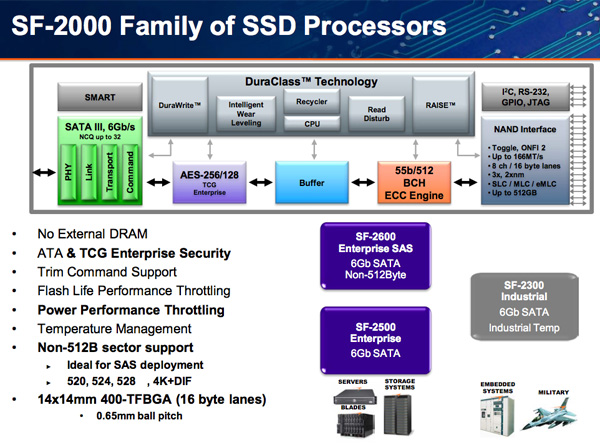SandForce Announces Next-Gen SSDs, SF-2000 Capable of 500MB/s and 60K IOPS
by Anand Lal Shimpi on October 7, 2010 9:30 AM ESTSecurity: AES-256 and Double Encryption
The SF-1200/1500 controllers have a real time AES-128 encryption engine. Set a BIOS password and the drive should be locked unless you supply that password once again (note I haven’t actually tried this). The SF-2000 implements an AES-256 engine and supports double encryption. The former enables stronger encryption, while the latter allows you to set a different encryption key for multiple address ranges on the drive.

Enhanced ECC
As NAND densities go up, so will error rates and in response SandForce boosted the error correction engine on its controller. The SF-2000 error checks and corrects at a 512-byte granularity with a 55-bit BCH, up from 24-bits per 512-bytes.
The Family
SandForce is announcing three parts today: the SF-2300, SF-2500 and SF-2600. All three controllers have the same performance specs but differ in features.
The SF-2500 is the base enterprise drive. For industrial use there’s the SF-2300 that can operate at more ridiculous temperatures. The SF-2600 ships with the external SAS bridge and a special firmware revision to enable support for non-512B sectors.

Many enterprise storage systems use larger-than-512B sectors to store error correction information among other things. These sizes can be awkward like 520 bytes, 524 bytes, 528 bytes or even a 4K sector with an additional data integrity field. Currently the SF-1200/1500 controllers support these non-standard sector sizes, but you run into performance issues since writes aren’t aligned to how the drive is organized internally. With the SF-2600, there’s firmware support for any one of these sector types. The drive handles alignment issues in hardware, presumably without any performance overhead. SandForce indicated that you’d need to configure the drive for sector size in the firmware, meaning the adjustment isn’t dynamic.
Since this is a very particular type of enterprise SSD feature that’s usually seen in SAS devices, the SF-2600 is paired with a native SAS to SATA bridge. The controller is still SATA internally but the SF-2600 reference design will feature a SAS bridge on-board.
All of the enterprise SF-2000 controllers support TRIM. They also support performance throttling based on remaining program/erase cycles on the drive’s NAND (slow down the drive so the NAND lasts longer, as well as power based performance throttling (slow down the drive to reduce power consumption). SandForce hasn’t announced power specs for the SF-2000 drives, but given Intel’s drive power went up with the 3rd generation X25s I would expect something similar here.
The consumer member of the SF-2000 family will be announced sometime early next year. We will hopefully see a fairly high end version of the consumer part, missing only the enterprise specific features but retaining all of the performance.










84 Comments
View All Comments
ibudic1 - Thursday, October 7, 2010 - link
Intel will be slower, but I bet it will be more reliable.Intel will also be able to offer twice the storage for the same amount 22nm vs 32 nm.
So high stable performance and twice the area, vs fast and small. So far all of this is vaporware.
Nihility - Thursday, October 7, 2010 - link
I wouldn't call the Intel product vaporware. It's almost guaranteed that they'll ship them on time.ggathagan - Friday, October 8, 2010 - link
I believe ibudic1 was referring to the Sandforce controller as vaporware, not Intel's product.sbrown23 - Thursday, October 7, 2010 - link
You mean 25nm vs 34nm? And Intel products are generally not vaporware. They have a fairly good record of delivery. This isn't Duke Nukem Forever, here.anindividual - Thursday, October 7, 2010 - link
http://www.plianttechnology.com/They have had an enterprise drive line with a proprietary controller on the market for over a year with much of this capability.
bji - Thursday, October 7, 2010 - link
That link indicates that the company in question is using SLC flash in their drives. This is guaranteed to put them out of the same price range as the Intel and Sandforce MLC drives, the latter already being expensive enough to be seriously limited in their market uptake. Conclusion: almost nobody is buying the Pliant Technology drives because they are too expensive compared to other options.mino - Thursday, October 7, 2010 - link
Nobody is willing to go for MLC in REAL enterprise drives.X25-E and the Sandforce stuff is mostly good for HPC and lower mid-range, but mostly DAS setups.
The EMC's of this world use far more robust (and far more pricey) solutions.
nexox - Thursday, October 7, 2010 - link
"""X25-E and the Sandforce stuff is mostly good for HPC and lower mid-range, but mostly DAS setups."""X25-E is an SLC drive. The X25-M is MLC.
"""Nobody is willing to go for MLC in REAL enterprise drives."""
You'll find that vendors are not targeting MLC at enterprises, but rather eMLC, which is somewhat different.
And you'd be wrong about enterprises wanting to avoid eMLC drives. They (will) serve pretty well for many work loads, in places where SLC is cost prohibitive, and spinning disks are too slow.
Casper42 - Friday, October 8, 2010 - link
"Nobody is willing to go for MLC in REAL enterprise drives" ????I work for HP in the Server division and all I can legally tell you is your WRONG.
PS: Ever heard of a slow little drive called the ioDrive Duo? The 640GB model uses MLC. I recently sold 3 of these to a Global 100 company that plans to run a SQL based Data Mining app on them.
HachavBanav - Friday, October 8, 2010 - link
Pliant "LB 150S" = 150GB (2.5" + SLC + SAS dual port ) for $4500 !@anindividual : please ask your boss to review the price, this is just non-sense !